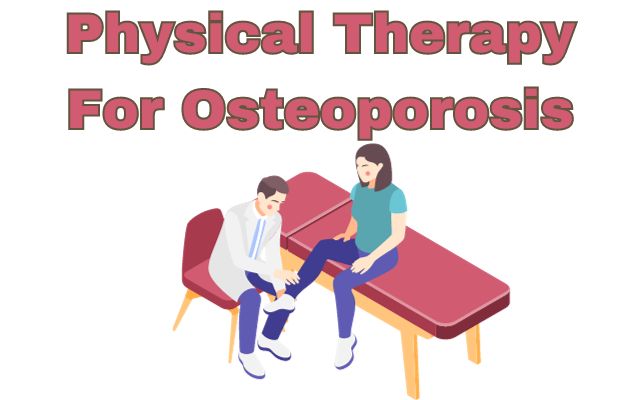Physical Therapy For Osteoporosis: A Complete Report

Physical therapy for osteoporosis can help improve bone density and reduce the risk of fractures through targeted exercises and education. Osteoporosis is a long-term disorder defined by a reduction of bone mass and density, which increases the risk of fractures.
It can affect anyone, and the risk increases with age. As per the National Institutes of Health (NIH), if the disease runs in your family, you’re more likely to have it. Medication, dietary and lifestyle changes, and PT are common treatments.
It can be prevented and managed by physical therapy for osteoporosis, often known as physiotherapy. Over the course of weeks and months, a therapist builds a tailored training regimen to strengthen your bones and muscles. This aids in improving your balance and lowering your risk of falling.
PT can also help you recover from an osteoporosis-related injury and improve your quality of life if you’re in pain.
Risk Factor For Osteoporosis
Osteoporosis is a condition characterized by weakening of the bones, which leads to an increased risk of fractures. Several risk factors can contribute to the development of osteoporosis. These risk factors can be grouped into two categories: non-modifiable and modifiable.
Non-modifiable risk factors:
- Age: The risk of osteoporosis increases with age, as bone density naturally decreases over time.
- Gender: Women are at a higher risk of developing osteoporosis than men, especially after menopause, due to lower estrogen levels.
- Family history: If you have a family history of osteoporosis, you may be more susceptible to the condition.
Modifiable risk factors:
- Low body weight: Being underweight can increase the risk of osteoporosis, as there is less bone mass to lose.
- Poor nutrition: Inadequate intake of calcium and vitamin D, essential nutrients for bone health, can increase the risk of osteoporosis.
- Lack of physical activity: A sedentary lifestyle can contribute to bone loss. Weight-bearing exercises help maintain bone density.
- Smoking: Smoking can reduce bone density and increase the risk of fractures.
- Excessive alcohol consumption: Heavy alcohol intake can weaken bones and reduce bone density.
- Medications: Long-term use of certain medications, such as glucocorticoids (e.g., prednisone) and some anticonvulsants, can increase the risk of osteoporosis.
- Medical conditions: Certain medical conditions, such as rheumatoid arthritis, celiac disease, and hormonal disorders, can affect bone health.
- Hormonal changes: Hormonal imbalances, such as early menopause or low testosterone levels in men, can contribute to bone loss.
- Low estrogen levels: In women, early menopause or surgical removal of the ovaries can lead to a significant decrease in estrogen, which is important for bone health.
What Is Osteoporosis Screening
This disease is known as a “silent” illness because it generally goes unnoticed until it leads to a bone fracture. Regular osteoporosis examinations are recommended by the US Preventive Services Task Force for women 65 and older, as well as postmenopausal women with certain risk factors.
Read Also- Norovirus In Children: Report On Cases Rise In Nurseries
Physical Therapy(PT)
A skilled therapist assesses and resolves anomalies in your movement caused by injuries or other health concerns during physical therapy.
Therapists in the United States must obtain a PhD in PT and pass a national licensure board exam. Most physical therapy programs run three years and require an undergraduate degree to enter, according to the American Physical Therapy Association (APTA). Therapists must be licensed in each state in which they operate, and the standards differ from state to state.
Stretching and exercises are commonly used in physical therapy, and they are usually done in sets or repetitions. Therapists, on the other hand, employ a range of additional strategies to help people move better.
Your physiotherapist will ask you some questions as well as perform physical tests at your initial visit to assess your symptoms and pain levels. The types of exercises you’ll do, as well as the difficulty and number of times you’ll do them, will be determined by your injury and overall health. As you gain strength, exercises will frequently vary or become more difficult.
Therapists may have you practice these exercises in their office, but it’s also usual for them to give you routines to do on your own every day.
Needs Physical Therapy For Osteoporosis
If You Have Any Of The Following Symptoms, PT May Be Recommended:
- You’ve been diagnosed with osteoporosis.
- You recently had an osteoporosis-related fracture.
- You’re an older adult with a family background of osteoporosis.
- You have a medical problem that is impacting your bone health.
Regular exercise is essential for maintaining bone strength and health. People with a moderate to high risk of fracture or functional impairments may benefit from working with a therapist, according to a study. They can design a personalized program to reduce the risk of harm in the future.
The authors advocate a long-term exercise program to increase postural stability, mobility, and movement efficiency to avoid this disease and osteoporotic fractures. This is in addition to increasing calcium and vitamin D intake.
Physical Therapy for osteoporosis can also aid in the recovery of fractures in persons with this disease. Ultrasound and electrical stimulation are two treatments that may help control chronic pain. In addition to PT, pain medications and pharmaceuticals particularly designed to treat osteoporosis can be beneficial.
Types Of Exercises
The exercises prescribed by a therapist for Physical Therapy for osteoporosis are determined by various criteria, including:
- The type of injury or health condition for which you are being treated.
- Your overall health, as well as how any pre-existing diseases may impact your treatment.
- The amount of physical exercise you engage in on a daily basis or at work
- Set your own PT objectives
According to the study, Physical therapy for osteoporosis exercises are usually simple, don’t require expensive equipment, and can be done at home.
Note- It’s important that you follow your therapist’s instructions to ensure that you’re performing exercises correctly. They may also provide you with infographics or videos to use as a guide.
Stop and see your physiotherapist if you’re worried you’re not doing an exercise correctly or if it’s giving you pain.
According to the American Physical Therapy Association, your therapist will likely consider a combination of resistance as well as weight- bearing Physical Therapy for osteoporosis This treatment plan will be extremely personalised.
The following items may be included in your treatment plan:
- With optimal alignment, weightlifting
- Exercises with tension bands
- Pushups, squats, and yoga positions are examples of resistance exercises.
- Walking, dancing, or stair climbing are examples of weight-bearing exercises.
- Posture-improvement exercises
- Exercises to improve balance
- Exercises to help you stay aligned in your day-to-day activities
The two most effective types of exercise for boosting bone density in patients with osteoporosis were discovered in a study. Weight-bearing aerobic exercises like stair climbing or walking, as well as resistance training exercises like lifting weights, were included.
Resistance training seeks to increase bone density and muscular mass. This form of exercise has also been linked to better sleep quality and a lower risk of death, among other health benefits.
Benefits Of Physical Therapy For Osteoporosis
People with osteoporosis who workout have a better quality of life than those who do not, according to a study.
Physical activity can enhance balance, strength, and endurance of muscles in the spine in persons with osteoporosis, while also reducing discomfort and anxiety of falling, according to a review of studies.
The researchers also discovered that beginning Physical Therapy for osteoporosis was linked to better outcomes.
However, further research is needed to determine which treatments are most effective, as well as how long and how often they should be used.
In a 2020 study, researchers discovered that a 12-week exercise program overseen by a physiotherapist helped women having osteoporosis and a risk of vertebral fractures increase muscle strength, balance, as well as fear of falling.
Suggestions For Physical Activity
The World Health Organization (WHO) provides recommendations for suggested levels of activity for each age group.
Experts Advise:
- Adults between the ages of 18 and 64 should engage in at least 150 to 300 minutes of moderate level aerobic physical activity or 75 to 150 minutes of vigorous intensity aerobic physical exercise per week.
- Adults with chronic illnesses should follow this advice as well.
- Adults over the age of 65 should strive for the following and prioritize functional balance and strength exercise three times per week.
Finding A Physical Therapist
You might ask your doctor for a referral to a therapist in your region. A doctor’s note isn’t necessarily required to see a therapist, but it may be required by your insurance carrier.
By phoning or visiting your insurance company’s website, you may be able to obtain a list of in-network providers.
You can look for clinics and physical therapists in your region using the APTA’s free online directory.
Conclusion
Osteoporosis is a widespread bone disease that affects mostly older and postmenopausal women. On the other hand, can affect anyone. It causes a loss of bone density and mass, as well as the risk of fractures.
PT, in conjunction with other therapies, may aid in bone and muscle strengthening. It can assist you in improving your balance and reducing your chances of falling.
It’s crucial to discuss what is osteoporosis screening with your doctor as you get older, particularly if you have a family history of the condition or are over 65 years old. If a test finds you’re at moderate or severe risk of fracturing a bone, your doctor may suggest training with a physiotherapist.
People May Ask
What is physical therapy for osteoporosis?
Physical therapy for osteoporosis involves a specialized approach to improve bone health, increase strength, and reduce the risk of fractures through targeted exercises, posture correction, and education.
Who can benefit from physical therapy for osteoporosis?
Individuals diagnosed with osteoporosis or those at risk of developing it can benefit from physical therapy. This includes postmenopausal women, seniors, and anyone with known risk factors.
What are the goals of physical therapy in osteoporosis management?
The primary goals are to improve bone density, enhance muscle strength, enhance balance, and reduce the risk of falls and fractures.
Can physical therapy help with pain associated with osteoporosis?
Yes, physical therapy can help alleviate pain and discomfort associated with osteoporosis by strengthening muscles and improving overall body mechanics.
What types of exercises are typically included in a physical therapy program for osteoporosis?
Physical therapists may include weight-bearing exercises, resistance training, balance exercises, flexibility work, and posture training to enhance bone health and reduce the risk of falls.
Is it safe to engage in physical therapy if I already have osteoporosis and fragile bones?
Yes, physical therapy programs are designed to be safe and tailored to an individual’s bone density, so they can help without increasing the risk of fractures.
How long does a typical physical therapy program for osteoporosis last?
The duration of a program can vary based on individual needs. Some individuals may benefit from a short-term program, while others may require ongoing maintenance exercises.
Can physical therapy replace medication in osteoporosis treatment?
Physical therapy is often used as a complementary treatment to medication. It can help manage the condition and improve overall bone health but may not replace medication in some cases.
Are there specific exercises or movements that individuals with osteoporosis should avoid?
Yes, individuals with osteoporosis should avoid high-impact activities and exercises that involve heavy lifting or twisting the spine. A physical therapist can provide guidance on safe exercises.
How can I find a qualified physical therapist for osteoporosis?
You can ask your primary care physician for a referral, or you can search for physical therapists with expertise in osteoporosis management through online directories or local healthcare providers.
Are there lifestyle changes that complement physical therapy for osteoporosis?
Yes, maintaining a healthy diet rich in calcium and vitamin D, not smoking, and limiting alcohol intake can support the benefits of physical therapy.
What should I expect during my first physical therapy session for osteoporosis?
During the initial session, the therapist will conduct an assessment of your condition, discuss your goals, and create a personalized treatment plan that includes exercises and education.
How often should I attend physical therapy sessions for osteoporosis?
The frequency of sessions varies, but initially, it may be recommended to attend 2-3 times a week, with the possibility of reducing the frequency as progress is made.
Can physical therapy prevent osteoporosis in the first place?
While physical therapy can be a preventive measure by promoting bone health and fall prevention, it cannot guarantee the prevention of osteoporosis.
What are some signs that physical therapy is working for osteoporosis management?
Signs of progress include increased muscle strength, improved balance, reduced pain, and enhanced bone density as measured through bone density scans.
Is PT Effective In The Treatment Of Osteoporosis?
PT is a non-surgical treatment for osteoporosis that works well.
What Kind Of Exercise Is Best For Osteoporosis?
Walking, dancing, low-impact aerobics, elliptical training equipment, stair climbing, and gardening are just a few examples.
What Kind Of Treatment Is Utilized To Treat Osteoporosis?
Bisphosphonates are typically the first line of treatment for osteoporosis.
Is Walking Beneficial To Osteoporosis?
Regular activity, such as walking, can help to prevent bone loss. Regular brisk walking can help keep your bones strong and lower the chance of a future fracture if you have osteoporosis or brittle bones.
What Are Three Bone-Building Activities?
Exercises such as jumping jacks, running, brisk walking, and weight-lifting
Disclaimer
The opinions presented in this article should not be regarded as a replacement for medical advice. For more information, please contact your treating physician.



